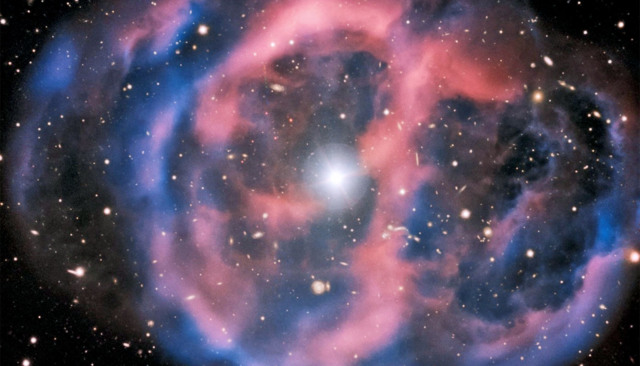Astronomers have discovered new kind of pulsating star that changes brightness every five minutes. What is it trying to say?!

Astronomers have a “new kind” of “pulsating star” that “changes brightness” every five minutes. Yo, you can’t fool me! Something is communicating to us from the Beyond! I’m just fucking around, but this is dope.
Science Alert:
A star with an interrupted death sequence could be the progenitor of a type of star that’s totally new to science. Astronomers have just discovered type of very small, very hot star that brightens and dims every few minutes as its outer layers try to maintain equilibrium.
The stars have been named hot subdwarf pulsators, and they could be related to another type of rare and mysterious recently discovered star: the blue large-amplitude pulsator.
So what’s so weird about these strange, pulsating stars?
“Many stars pulsate, even our Sun does on a very small scale,” said physicist Thomas Kupfer of UC Santa Barbara’s Kavli Institute for Theoretical Physics.
“Those with the largest brightness changes are usually radial pulsators, ‘breathing’ in and out as the entire star changes size.”
But even though our Sun pulsates, its cycle is 11 years, and it only varies in brightness by 0.1 percent over that timeframe, so it wouldn’t be considered a pulsator.
The brightness of pulsators can vary by up to a huge 10 percent due to changes in size and temperature.
The four new stars the team identified in data from the Zwicky Transient Facility survey pulsate on timescales between every 200 and 475 seconds, varying in brightness by around 5 percent.
Such a change in brightness can be produced by eclipsing binaries, so this needed to be ruled out before they could be classed as a new type. Once the research team had done that, they realised they could be looking at a new class of subdwarf B stars.
Subdwarf B stars are interesting. They are pretty tiny, size-wise – maybe 10 percent of the size of the Sun. But they are pretty dense, too. Into that small diameter, they squeeze between 20 and 50 percent of the Sun’s mass.
They burn very hot, towards the blue end of the spectrum, between 20,000 and 40,000 Kelvin. So they’re also very, very bright. It’s thought that they form along the evolutionary path of a star up to eight times the mass of the Sun as it dies.
When these stars run out of hydrogen to fuse in their cores, they start fusing helium, ballooning out into a red giant. A subdwarf B star is what happens when the outer hydrogen layers of a red giant are stripped away before helium fusion begins – possibly by a binary companion, but the exact mechanisms are unknown.
So there you have a tiny, hot, dense blue star. And some of them do pulsate.
The V361 Hya class have a pressure oscillation mode, which means their pulsations are produced by internal pressure fluctuations in the star. The V1093 Her class are gravity-mode pulsators, produced by gravity waves (not to be confused with gravitational waves).
The researchers are still looking into the exact mechanism behind the oscillations of hot subdwarf pulsators, but believe it may be unstable radial modes produced by something called the iron kappa mechanism, whereby a buildup of iron in the star produces an energy layer that results in a pulsation.
They also believe another difference could be what’s happening in their cores. Subdwarf B stars are generally considered to be fusing helium, either in their core, or a shell around the core. But the researchers believe that hot subdwarf pulsators lost their outer material before the helium was hot and dense enough for fusion.
“We were able to understand the rapid pulsations by matching them to theoretical models with low mass cores made of relatively cold helium,” explained physicist Evan Bauer of UC Santa Barbara.
The researchers also found that the pulsation resembles that of blue large-amplitude pulsators, a type of star just discovered in 2017. That means that the two types of stars could be related.
The next step will be to further characterise what’s actually happening inside these stars to produce the pulsations, and figure out precisely where the stars fit into models of stellar evolution.
The research has been published in The Astrophysical Journal Letters.



